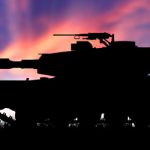Outlook for Franco-German Defence and Security Cooperation
Events of the past 12 months, including the Parisian terror attacks, Brexit, and uncertainty surrounding President-elect Trump’s plans for NATO, have led to increased defence cooperation between France and Germany. These developments have the potential to bear significant strategic consequences for the defence industry, as Europe’s second and third largest defence customers will likely opt for gradually more interoperable capabilities.
Europe’s second and third largest defence customers will likely opt for gradually more interoperable capabilities.
The terror attacks on the Franco-German soccer friendly and the city of Paris in 2015 were only the beginning of a sequence of events driving the increasingly close defence cooperation between France and Germany.
In the past 12 months, Brexit, joint operations against the Islamic State, and uncertainty regarding President-elect Donald Trump’s campaign statements on NATO have all been incentives for the two European partners to push for closer cooperation.
From an industrial perspective, these developments bear significant strategic consequences since Europe’s second and third largest defence customers will likely opt for gradually more interoperable capabilities.
French Minister of Defence, Jean-Yves Le Drian & German Minister of Defence, Ursula von der Leyen at the Munich Security Conference 2016. Image source: MSC/Kleinschmidt
Historically, no defence cooperation between any two European states can claim to have had as much impact on the European defence industry as Franco-German collaboration. The long list of past, successful (and failed) projects includes anything from transport aircraft or anti-tank weapons to the joint Franco-German Brigade headquartered in Müllheim.
However, many operational and procurement efficiencies were repressed on the EU level by the UK government’s fear of serious EU defence integration.
Brexit has now opened a window of opportunity for the overstretched French and underinvested German military to join forces and efficiently strengthen their respective capabilities.
This fall, Minister Von der Leyen and Minister Le Drian have seized this opportunity and published a brief summary outlining the focus of investment for the two countries going forward.
Among the defined areas of cooperation for European industry are:
- Cyber defence,
- Medium Altitude Long Endurance Remotely Piloted Aircraft System,
- SATCOM, and
- Air-to-air refuelling capabilities.
Brexit has now opened a window of opportunity for the overstretched French and underinvested German military.
Despite these promising political developments, several roadblocks are apparent in the not-too-distant future. For instance, the German Economic Ministry is currently reviewing the country’s defence export legislation, a politically sensitive topic between the two partners which has only gained in relevance since the KMW-Nexter merger.
Moreover, the upcoming elections in both countries (France in May & Germany in September 2017) hold much potential to upset the recent post-Brexit push for defence cooperation.
The policy suggestions of the French ‘Front National’ seriously question European cooperation and in Germany an election success for the ‘Alternative for Germany’ could significantly weaken a future German governing coalition’s stance on further European integration on all levels.
Cooperation is often easier in nascent technology areas.
The following highlights some of the most pertinent areas of cooperation for European defence industrial stakeholders, as well as selected opportunities and challenges associated with agreed-upon and potential areas of Franco-German cooperation.
![]() MALE RPAS: In September of this year, the consortium made of Airbus, Dassault Aviation, and Leonardo-Finmeccanica initiated the definitional study for the Medium Altitude Long Endurance Remotely Piloted Aircraft System (MALE RPAS), a chance to develop a modern European ISTAR capability that was long overdue.
MALE RPAS: In September of this year, the consortium made of Airbus, Dassault Aviation, and Leonardo-Finmeccanica initiated the definitional study for the Medium Altitude Long Endurance Remotely Piloted Aircraft System (MALE RPAS), a chance to develop a modern European ISTAR capability that was long overdue.
However, US competitors enjoy a significant technological advantage and it will be an uphill battle for European industry to compete internationally. Opportunities to provide cutting-edge ISTAR payloads will likely present themselves further down the road for industry partners on both sides of the Atlantic.
Takeaway: Any technological difficulties in this area should be manageable but international competition and political priorities could still endanger the project.
![]() Operation & Maintenance: Given the ongoing delays of the Airbus A400M military transport aircraft, airlift remains a significant gap in the capabilities of both France and Germany. As of this summer, the German MoD decided to station six new C-130J aircraft in France, sharing the cost of O&M and training with the existing French fleet.
Operation & Maintenance: Given the ongoing delays of the Airbus A400M military transport aircraft, airlift remains a significant gap in the capabilities of both France and Germany. As of this summer, the German MoD decided to station six new C-130J aircraft in France, sharing the cost of O&M and training with the existing French fleet.
This recent example of cooperation shows how O&M services demand could consolidate across the two countries as they offer relatively quick economies of scale with less political hurdles than cooperation on ‘hard’ capabilities.
Takeaway: Much room for growth presents itself for increasing joint O&M for common or similar platform and systems. Whether these opportunities materialise will largely depend on the relevant procurement agencies.
![]() KANT: Already in 2014, the German parliament initiated a request for the development of a future ’Leopard III’ and the CEO of KMW even suggested a first prototype within the 2025-2030 timeframe to meet demand to modernize NATO’s land forces.
KANT: Already in 2014, the German parliament initiated a request for the development of a future ’Leopard III’ and the CEO of KMW even suggested a first prototype within the 2025-2030 timeframe to meet demand to modernize NATO’s land forces.
However, the new merger is nascent and will still need to prove that it can cater to the customer preferences of both, the German and French customer.
Takeaway: The KANT project will be the yard stick determining the feasibility of cooperation on the industrial side; if new product development is successful it could result in significant opportunities for French and German suppliers.
![]() Future Initiatives: In addition to the politically agreed-upon areas of cooperation, French and Germany industry are both exploring very similar capabilities for future platforms and systems.
Future Initiatives: In addition to the politically agreed-upon areas of cooperation, French and Germany industry are both exploring very similar capabilities for future platforms and systems.
For example, Rheinmetall, MBDA Germany, CILAS, Thales, and Safran (Optics) all pursue High-Energy Laser systems or components. These and other projects, often categorised as ‘Third Offset Capabilities’ in the United States, offer significant room for industry cooperation.
Takeaway: Cooperation is often easier in nascent technology areas, and they offer a chance for French and German industry to shape a future market, encompassing both countries, from the very beginning of a project.
Other areas of cooperation on the political agenda include Cyber Defence and military Satellite Communication. However, cooperation in these will likely face more hurdles given growing national interest in cyber and the importance of SATCOM. Therefore, as of now these are considered to be less likely to represent near-term opportunities for French and German industry.





